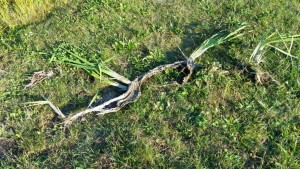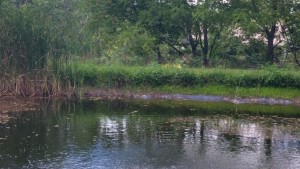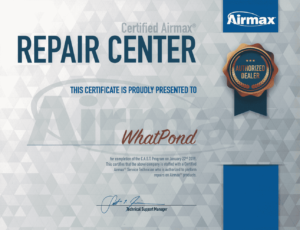Cattails are good for the pond but can become unruly and want to take up more area than we want them to have. Once they get started they will continue to grow along the shore and out into the water to a point of 4’ deep.
Hand removal is one tough method, meaning it is a work out getting into the pond and pulling these guys by the roots. But starting out in the water is the easiest place to start since the root is not so in bedded in the bottom of the pond. If you star at the farthest cattail out in the water you can get the root and work your way back to shore, following the root. As you get closer to shore you’ll notice that root will be getting tougher to pull up as it is deeper into the pond floor. If the root breaks find it again and keep working it out to the next stalk or find that next stalk to pull and maybe it will be the one going to the broken root.
As you get closer to shore the roots are tougher to get out but also there are plenty more roots that are intertwined going in every direction. This is when it becomes even harder to pull them and you may need a shovel to help work them lose. Pulling by the roots will help to control the cattails growth and spread of the cattails. The hope is to eventually keep them out of the pond if that is the direction you want to go.
Mechanical by cutting the cattails will help to remove the mass of plant, the green stalk from the pond so we are not adding to the nutrient load of the pond creating more muck and nutrients for next year’s growth of the cattails, algae and other weeds. But cutting will not help with the control or spread of the cattails since the roots are still in the pond bottom ready to sprout as soon as they can. It is a good idea if you don’t want to pull them up by the roots that you at least cut them close to the water to get rid of the main stalk but also the seed head on top of the stalk, the round brown fuzzy thing at the very tip so they don’t end up adding new seeds for more cattails to grow.
The image below shows a before and after shot of thinning the cattails and weeding the shallow spot in the fore ground. You will also notice the color of the water changed, this was due to stirring up the fine clay particle as the cattail roots cam out of the bottom. The pond cleared up in a few days.
Another thought on the mechanical weed removal is using a backhoe to reach out with the backhoe bucket and lightly scoop out the out roots and cattails all at once. Also with this method I want to throw out a really big CAUTION removing cattails with powered machinery. If your pond was built with a thin layer of clay it is very possible to create a leak in the pond. So be sure you are not digging through a thin layer of clay causing a bigger problem than having cattails.
Yes there are chemicals that can be used on cattails to slow their growth and eventually kill them to the roots. It is not a one and done type treatment and will need to be repeated until they are dead or your desired amount of cattails are reached.
One last method that has been working is the Lake Blanket, not just for cattails but all types of weeds that are rooted in the bottom sediments of the pond. Focusing on cattails the plan is to cut the cattails as short as you can then install the Lake Blanket. Once installed we waited a year, then cut the next section of cattails down and moved the blanket to kill the next section of cattails. Remember that the cattail roots may be in the bank or up on shore, so the one plant can provide oxygen for new growth for more plant to start in the pond Find that stalk and dig it out by the roots.
A you can see there are plenty of ways to get rid of or control the cattails. They do have benefits or habitat for fish and wildlife and can be used as a tell tail sign you may have muskrats if you see them floating in the water, one of the muskrats favorite food.. Geese also tear up the cattails so keep an eye on the pond to see who maybe visiting the pond.
That’s all we have for now with the controlling of cattails, but as things change and progress we’ll keep you informed.
Video showing part of the cattail root system.





Comments on this entry are closed.